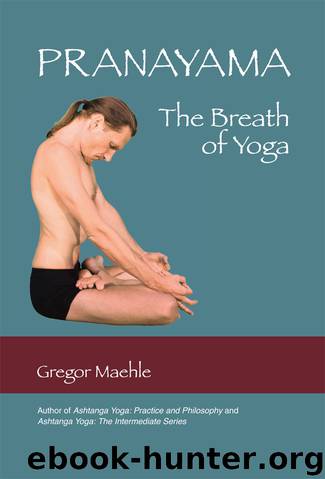Pranayama - The breath of yoga by Maehle Gregor

Author:Maehle, Gregor
Language: eng
Format: epub
Tags: Hatha yoga, Pranayama, Breathing exercises
Publisher: Kaivalya Publications
Published: 2014-02-21T16:00:00+00:00
KRIYAS
I am using the term kriya to refer to the gross purification processes that are called shatkarmas (six actions) in some texts and ashta karmas (eight actions) in others. In reality there are more than 40 kriyas, when the subdivisions are taken into consideration.
The Hatha Yoga Pradipika in chapter 2 first describes the main pranayama technique Nadi Shodhana (nadi purification) and then suggests the kriyas to those whose nadis are so clogged that Nadi Shodhana alone is not sufficient. Only after that does the Pradipika describe all the other various forms of pranayama. In other words the Pradipika suggests that some yogis may be in a condition good enough for the kriyas not to be required. However, Balakrishna, one of the commentators on the Hatha Yoga Pradipika, says that asanas and kriyas are both recommended as preparations to pranayama, as no single practice can eliminate all impurities.390 The Hatha Yoga Pradipika does, though, insist on the performance of the kriyas before pranayama if fat and phlegm are present in the student’s body, as these clog the nadis.391 This view is also held by the Yuktabhavadeva of Bhavadeva Mishra.392 Additionally, the 10-chapter edition of the Hatha Yoga Pradipika suggests, as an order of practices, first establishment in asana, then the purification of the nadis through kriyas and only then the practice of pranayama.393
The Gheranda Samhita states that purification can happen either through Nadi Shodhana with mantra or through the kriyas (purification processes).394 In any case, a teacher of yoga should know the kriyas in order to be able to teach them, even if she will not teach all the kriyas to all students. The Hatha Tatva Kaumudi gives us a different view of the importance of the kriyas. It proclaims that the gross body gets purified through the kriyas whereas the subtle (energetic) body is purified through pranayama, but its author, Sundaradeva, nevertheless admits that the kriyas are secondary to pranayama.395
The Hatha Ratnavali, authored by Shrinivasayogi, gives us some very important additional details. Firstly, he agrees that before pranayama the body must be purified through the kriyas [as asana alone is not sufficient to prepare for pranayama].396 He then goes on to explain that the kriyas purify the 6 chakras.397 Shrinivasayogi states that Nauli purifies the Manipura Chakra, Dhauti purifies the Anahata Chakra, Neti purifies the Ajna Chakra and so on. This amounts to ascribing to the kriyas the ability to purify the subtle body too. Jayatarama, the author of Jogapradipyaka, makes the kriyas compulsory by stating that they and pranayama are both necessary as preparation for samadhi.398
Let us turn to the views of modern authorities. O.P. Tiwari, director of Kaivalyadhama, says that meditation is not possible if the nadis are blocked, and if this is the case one may hypnotize oneself into the assumption that one is making progress in meditation whereas it is not the case.399 He accepts, however, that cleaning of the nadis can be brought about by such different tools as kriya, devotion to the Divine and pranayama.
Download
This site does not store any files on its server. We only index and link to content provided by other sites. Please contact the content providers to delete copyright contents if any and email us, we'll remove relevant links or contents immediately.
| Acupuncture & Acupressure | Aromatherapy |
| Ayurveda | Chelation |
| Chinese Medicine | Energy Healing |
| Healing | Herbal Remedies |
| Holistic | Homeopathy |
| Hypnotherapy | Massage |
| Meditation | Naturopathy |
| Reference |
Inner Engineering: A Yogi's Guide to Joy by Sadhguru(6725)
The Power of Now: A Guide to Spiritual Enlightenment by Eckhart Tolle(5605)
Fear by Osho(4662)
Ikigai by Héctor García & Francesc Miralles(4125)
The Art of Happiness by The Dalai Lama(4063)
The Ultimate Bodybuilding Cookbook by Kendall Lou Schmidt(3886)
Yoga Therapy by Mark Stephens(3703)
The Little Book of Hygge by Meik Wiking(3647)
The Healing Self by Deepak Chopra(3474)
Why Buddhism is True by Robert Wright(3404)
Being Aware of Being Aware by Rupert Spira(3229)
The Hatha Yoga Pradipika (Translated) by Svatmarama(3229)
Shift into Freedom by Loch Kelly(3134)
Wild Words from Wild Women by Stephens Autumn(3092)
Work Clean by Dan Charnas(3048)
Happiness by Matthieu Ricard(2992)
More Language of Letting Go: 366 New Daily Meditations by Melody Beattie(2966)
Yoga Body & Mind Handbook by Jasmine Tarkeshi(2835)
Why I Am Not a Feminist by Jessa Crispin(2695)
